Business
Rice sales strong for the week with good export demand
Strong sales figures reflect the good quality of US rice this year, as well as its competitive prices.
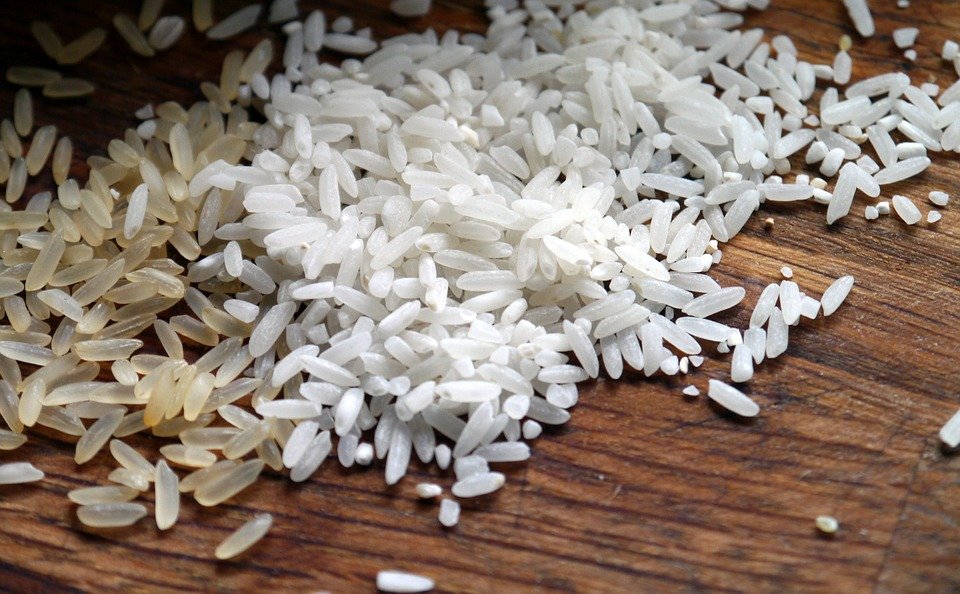
Report for the rice last week showed strong sales, and export demand for this year has been good so far.
Wheat
US markets closed slightly higher again last week. USDA increased export demand estimates in its monthly supply and demand updates with all of the increased demand coming in the HRW class. The weekly charts show that winter wheat prices are at the lowest levels since harvest and might now be cheap enough for sideways to higher trends to develop. Minneapolis has started on an uptrend and the indications of good demand for higher protein wheats continue.
Overall export demand has been about as projected by USDA, but ideas of ample supplies and strong competition from Russia keep futures pinned at cheaper levels. Argentina has also been offering into the world market and at some very attractive prices. Ukraine and Australia have reported smaller crops, and Brazil and Argentina have less even though Argentina is selling.
The US looks to plant fewer acres of wheat again this year, meaning that the US will have less area planted to wheat than seen over the last 100 or more years once again this year. Russia is looking to maintain its dominant position in the world market and is hoping to raise another huge crop this year. The government and the private analysts there are all forecasting another record crop. The government announced plans last week to improve the transportation infrastructure over the next three years to expand export capacity at ports and along the railroads. Ideas are that wheat prices can remain a sideways and choppy trade for now.

Weekly Chicago Soft Red Winter Wheat Futures © Jack Scoville
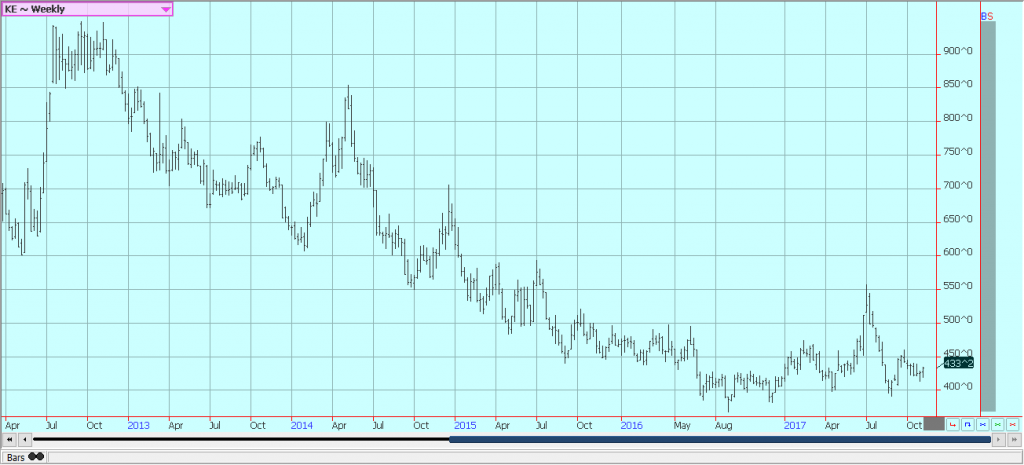
Weekly Chicago Hard Red Winter Wheat Futures © Jack Scoville
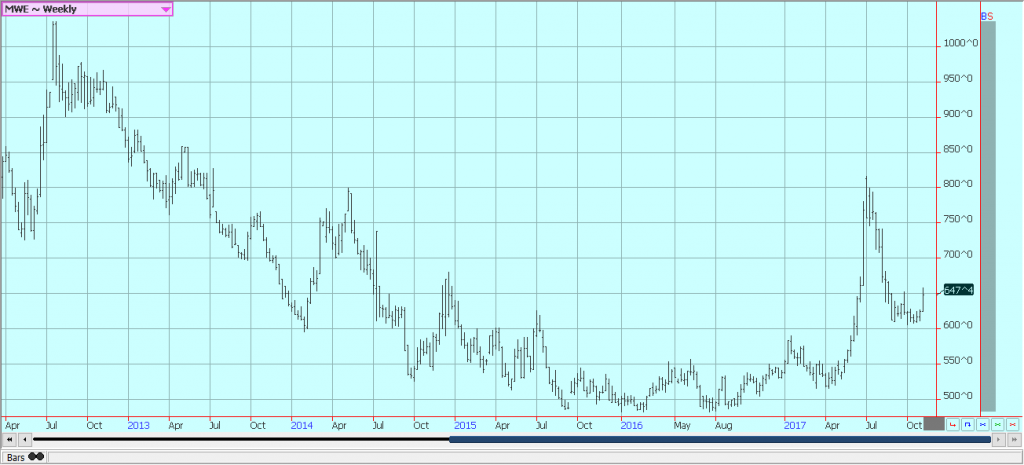
Weekly Minneapolis Hard Red Spring Wheat Futures © Jack Scoville
Corn
Corn closed moderately lower and oats closed higher and near the top of its recent trading range on the weekly charts. Corn made new lows for the move and new contract lows on the daily charts in response to the USDA production estimates that showed bigger production than anyone had anticipated. Production was estimated at over 14.4 billion bushels and the average national yield was a record at over 175 bushels per acre. This big production is coming after a growing season that featured very uneven weather and has been a shock to the trade.
The big production left the US ending stocks estimates well above all trade estimates for the current year. USDA also increased ending stocks estimates in its world data for the current year. Ideas are that the corn crop can be over 75% harvested when USDA releases its weekly progress reports on Monday afternoon The export sales report on Thursday was very strong for corn and was a reason to buy the market, but was overshadowed by the production estimates released later that morning. Basis levels remain generally weak but have continued to improve as the market starts to need some corn. There has been active demand from ethanol producers in response to higher gasoline prices.

Weekly Corn Futures © Jack Scoville
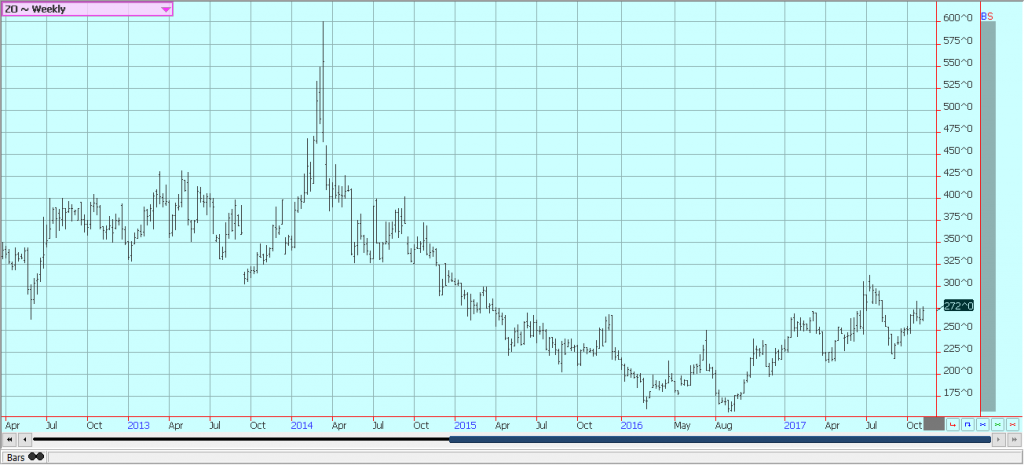
Weekly Oats Futures © Jack Scoville
Soybeans and Soybean Meal
Soybeans were near unchanged and soybean meal was a little higher. USDA released its latest production estimates and showed slightly higher than expected production at 4.4 billion bushels and unchanged yield estimates at 49.5 bushels per acre. The trade had expected USDA to slightly reduce the yield and production. USDA made no changed to its demand estimates in the monthly supply and demand reports, so ending stocks were a little higher than expected due to the higher than expected production. USDA showed higher soybeans production estimates for the coming year in Brazil as planting and growing weather there finally seems to be improving.
Chinese demand for US Soybeans remains strong and could improve after more framed contracts were signed in China during the Trump visit last week. The Chinese demand now is welcome as it had been sourcing almost all of its soybeans needs from Brazil. Soybean meal has also suffered from weak demand due to strong competition from DDGS in the market and on ideas that crush levels can remain strong due to the need to produce soybean oil for biofuels needs.
However, soybean oil started to move lower last week and that helped support soybean meal prices. There are still forecasts around for weather patterns to change in Brazil and bring some badly needed rain to the north and drier conditions to the south and into Argentina. Some beneficial rains have been reported in Mato Grosso and Mato Grosso do Sul, and reports indicate that fieldwork is active. It remains too wet to the south, but it has been drier in Argentina.
The US harvest is now about over in all areas of the US. The yield data generally runs behind year-ago levels, but are still very strong overall. Basis levels continue to improve in the interior as the harvest comes to a close. Soybeans are still holding an uptrend that started in mid-August but has found significant selling on rallies above $10.00 per bushel.
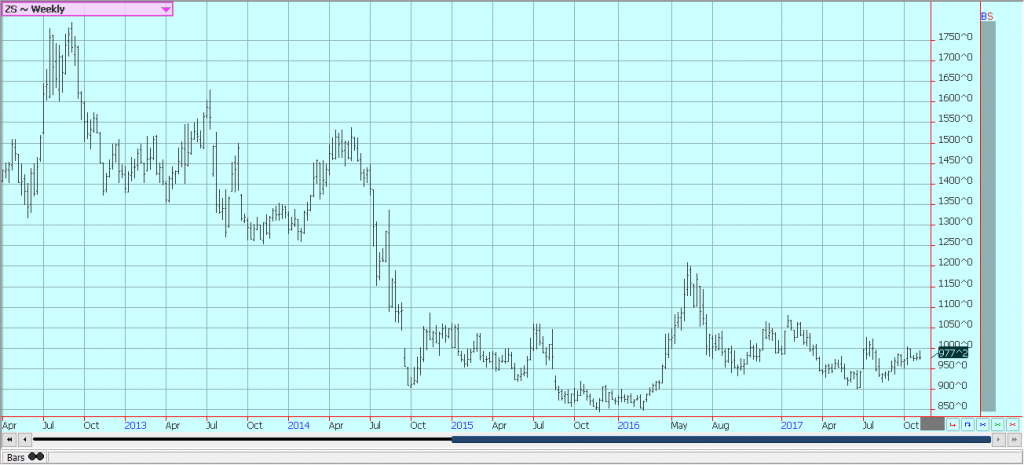
Weekly Chicago Soybeans Futures © Jack Scoville

Weekly Chicago Soybean Meal Futures © Jack Scoville
Rice
Rice closed lower for the week in quiet trading. The volumes traded reflect the slow cash market, but futures prices, in general, are well below cash market values that have held firm. The daily charts show the potential for a bottom to be forming and weekly charts show downtrends. The weekly charts show that futures have come close to objectives for the down move, so further price weakness might be difficult to see.
USDA showed marginally less production again in its estimates on Thursday morning, but also reduced export demand potential due to top the smaller crop. This led USDA to lower the average farm price slightly. World data showed reduced month to month ending stocks estimates as Indian production was revised down about 2.5 million tons. The sales report last week was strong, and export demand this year has been very good to this point.
The strong sales now show that the US quality is very good this year and also that the US is featuring competitive prices in these regions. Domestic cash market conditions are generally quiet with stable flat price bids. The Delta harvest is over and farmers are holding out for higher prices. The second harvest in Texas and Louisiana is coming to a close with more variable yields and quality. Reports from the country indicate good to very good yields and quality for the main harvest.

Weekly Chicago Rice Futures © Jack Scoville
Palm Oil and Vegetable Oils
World vegetable oils prices were mixed last week, with Chicago soybean oil closing a little higher, but canola and palm oil moving a little lower. The biggest loser for the week was palm oil, and that market got hurt when MPOB showed higher than expected production at about 2.01 million tons. The demand was about as expected, and ending stocks levels were in line with expectations. Private surveyors on Friday showed weaker export demand for the first third of the month.
Palm oil futures fell back to an uptrend line that has held since the middle of July, so this week could be an important week for determining short to medium term price direction. Canola was also lower, in part on currency considerations and in part on late week price action in Chicago soybeans and soybean oil. It has turned cold in the Prairies, so farmers are not as willing to sell. Farmers in the US are not selling a lot of soybeans, either, but prices have been turning weaker.
Chicago soybean oil prices made a short-term top late last week and saw selling pressure to close the week. US demand for soybean oil in biofuels should remain strong as the US moved to put punitive tariffs on imports from Indonesia and Argentina. Both countries are fighting these moves, and the process is moving to the courts. A final decision from the courts and then a real solution to the issue will likely take some time to be found.

Weekly Malaysian Palm Oil Futures © Jack Scoville
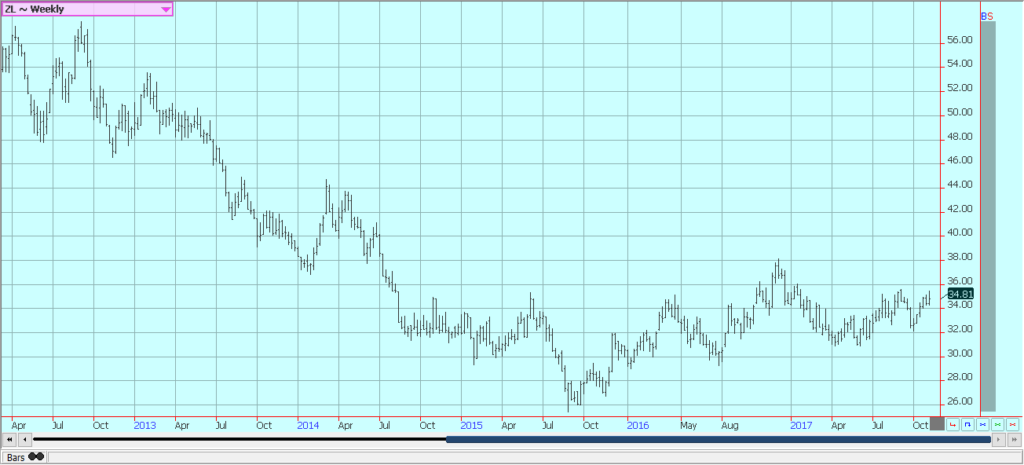
Weekly Chicago Soybean Oil Futures © Jack Scoville
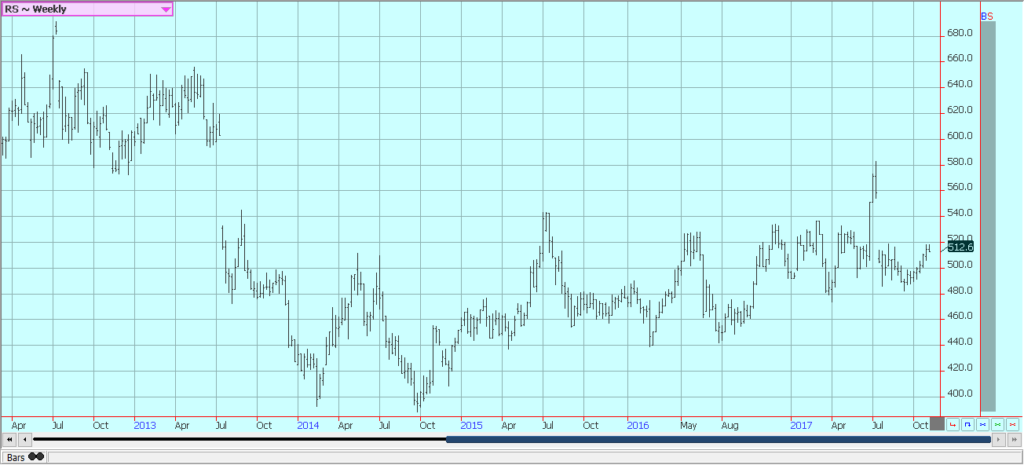
Weekly Canola Futures © Jack Scoville
Cotton
Cotton was higher for the day and a little higher for the week. The market absorbed higher production estimates from USDA in its monthly production reports at 21.3 million bales but held to the recent trading range. It was a midrange close for the week. World data showed reduced month to month ending stocks estimates on reduced production in exporter countries away from the US. The data imply that the US could see a little more demand than expected for the current year.
However, ending stocks estimates are currently above 6 million bales for the US, so there will be plenty of cotton available for any buyer. That implies that prices can continue to move in a sideways trend for now. Good harvest weather is expected this week. The increased production comes on the heels of some major weather events in the US. Cotton growing areas suffered from tow hurricanes and a freeze, so the strong production is remarkable. Producers now have good weather for the last half of the harvest and will probably start to move more quickly to get the crop out of the fields and into storage.
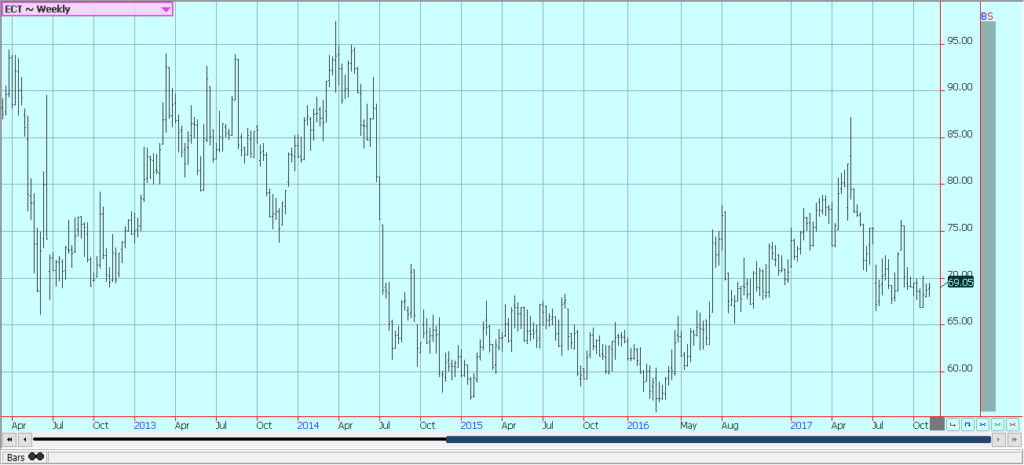
Weekly US Cotton Futures © Jack Scoville
Frozen Concentrated Orange Juice and Citrus
FCOJ closed higher on Friday and for the week as the market reacted to the USDA production reports. Production was lower again at 50 million boxes and the market started to work higher after an initial reaction down. The report once again highlighted the damage from the hurricane this year. Production is now about two-thirds of what was expected at the start of the growing season. The demand side remains weak.
However, for now, it looks like the supply side has taken over as the force in the markets. Brazil weather has improved as groves are now getting rains, but suffered from drought at the flowering time. It was also very hot and it is possible that production from Sao Paulo state will be less. The weekly charts indicate that higher prices are coming over time. Trees in Florida that are still alive now are showing the fruit of good sizes, although many have lost a lot of the fruit. Florida producers are actively harvesting what is left. The emphasis is on the fresh fruit market now, with processors only getting packinghouse eliminations at this time.

Weekly FCOJ Futures © Jack Scoville
Coffee
Futures were a little higher in New York and a little lower in London last week, with commercials, scale down buyers and speculators still the best sellers in New York, but now on both sides of the market. The trends are sideways on the charts in New York as traders look at the potential for a big crop in Brazil. The daily and weekly charts do imply that New York is about to complete a bottom and that prices could move higher for the next few weeks. London trends are mostly down.
The Brazil weather and tree condition is the main fundamental reason for movement in New York prices and could become the major reason to buy the market soon. Rains have been reported to coffee areas in Minas Gerais again, and many areas are reporting good conditions now after the earlier stress caused by the cold and dry winter. The rains will need to continue and be in good amounts as it has been very dry and trees have been stressed for a year or more in some cases. Some were stressed after the production last year, while others suffered due to the dry and cold winter.
Even so, improved weather now could mean a very good crop, although most likely not a huge crop of over 50 million bags. Brazil exported 2.7 million bags of coffee last month, down 18.3% from a year earlier. Cash market conditions in Central America are more active as the harvest continues. Differentials have been stable but weak in the region. Colombian exports have held well as production appears to be good. Differentials have been stable and relatively strong.

Weekly New York Arabica Coffee Futures © Jack Scoville
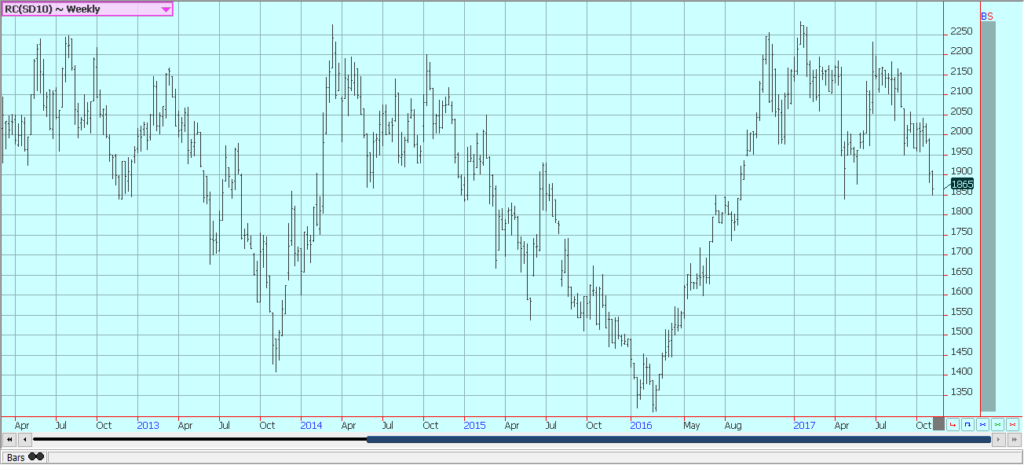
Weekly London Robusta Coffee Futures © Jack Scoville
Sugar
Futures were higher and short-term trends in New York turned up as March cleared some resistance just above 1450 on the charts. London chart patterns are also up as the market senses the reduced availability of sugar in the market. The market is rallying as UNICA showed reduced production of sugar as mills in Brazil decided to make more ethanol. The move by Brazil mills to produce more ethanol means less sugar available on the world market. Brazil is importing US ethanol to make up for short production, so the move by sugar mills in Brazil to supply the local
Ethanol market instead of the world sugar market makes economic sense. Weekly charts show trading ranges, but both imply that a bottom is being completed. Traders remain generally bearish on ideas of strong world production and lackluster demand. But, the move by Brazil mills to shift the production blend in favor of more ethanol for the domestic market takes some of the big sugar production out of the picture.
In addition, there are some questions about Indian production. The Sugar Association there does not anticipate the need for import but has not talked about exports after a bad production year last year. There does not seem to be any big demand coming from any real direction, especially as China has cut back on imports and the year to year loss in demand is a very big amount. Upside price potential is limited as there are still projections for a surplus in the world production, and these projections for the surplus seem to be bigger.

Weekly New York World Raw Sugar Futures © Jack Scoville

Weekly London White Sugar Futures © Jack Scoville
Cocoa
Futures closed higher on Friday and higher for the week as trends turned up again in both New York and London. Prices remain strong overall in response to positive demand news from as the North American and the European grind data released last month. The data showed increased demand, and chocolate makers have mentioned increased processing margins as a reason to produce more chocolate now.
World production ideas remain high. Harvest reports show good to very good production will be seen this year in West Africa. Ghana and Ivory Coast expects a very good crop this year. However, there have been some reports in Ivory Coast that diseases are hitting the crops and could reduce output in the end. Farmers have invested less in chemicals to protect and nourish crops due to low prices. Nigeria and Cameroon are reporting good yields on the initial harvest, and also good quality. The growing conditions in other parts of the world are generally good. East Africa is getting better rains now. Good conditions are still seen in Southeast Asia.
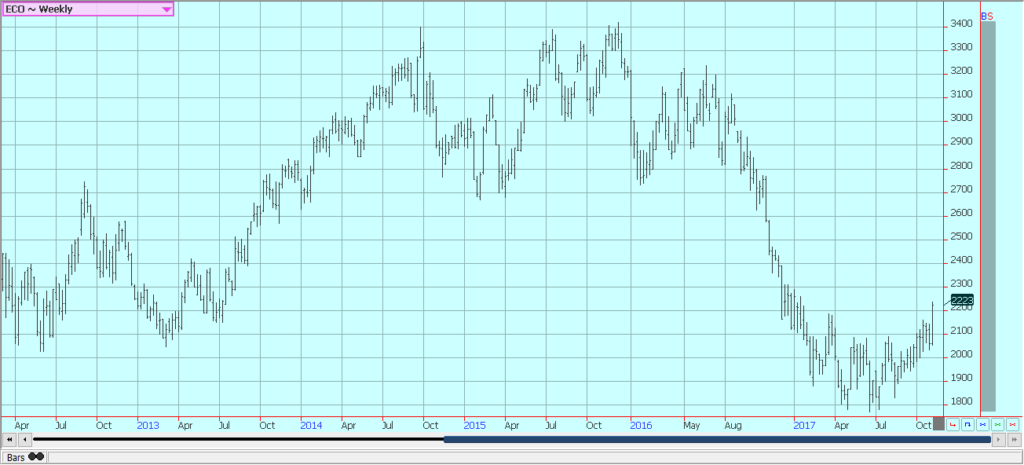
Weekly New York Cocoa Futures © Jack Scoville
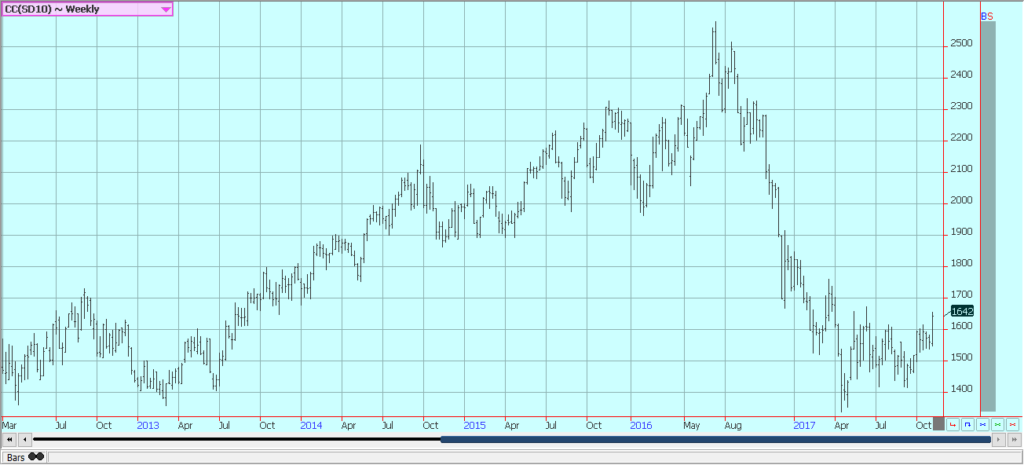
Weekly London Cocoa Futures © Jack Scoville
Dairy and Meat
Dairy markets were sharply lower again last week and Milk futures made new lows for the move. USDA reports ample supplies, but good to very good demand in just about all parts of the US. Milk and cheese demand has been mixed, but butter demand has weakened and prices in this market have moved sharply lower. Demand is good for cream, but cream has generally been available to meet the demand.
Cream demand for butter has been very good. Demand for ice cream has been mixed depending on the region, but is holding well due to mild weather in much of the US until late last week. Cheese demand still appears to be weaker and inventories appear high. US production has been generally strong.
US cattle and beef prices were lower, and futures prices have been moving lower. Beef prices are mixed, and cattle traded about $2.00 per hundredweight lower last week. Ideas are that packers are still enjoying very strong margins at this time and can afford to pay more for cattle. This did not happen last week.
Cattle prices were steady to slightly weaker amid lighter than expected volume. It is the threat of increased supplies down the road that keeps the packers from buying aggressively. Feedlots are full, but ideas are that the big offer of cattle has passed. The monthly Cattle on Feed report showed big placements, so prices should move lower this week in both live cattle and feeder cattle futures.
Pork markets and lean hogs futures were lower. Ideas are that futures are reflecting the weaker supply and demand fundamentals now, but the overall market seems to be holding. Demand has been improved for the last couple of weeks and this has affected pricing. There are still ideas of bug supplies out there, but the market seems to have the supply side priced. The weekly charts show that the market is trying to form a low at current prices, and futures have been cheap enough that a low is possible at this time. The weekly charts suggest that futures are developing a new trading range between about 6000 and 6800 basis nearest futures.
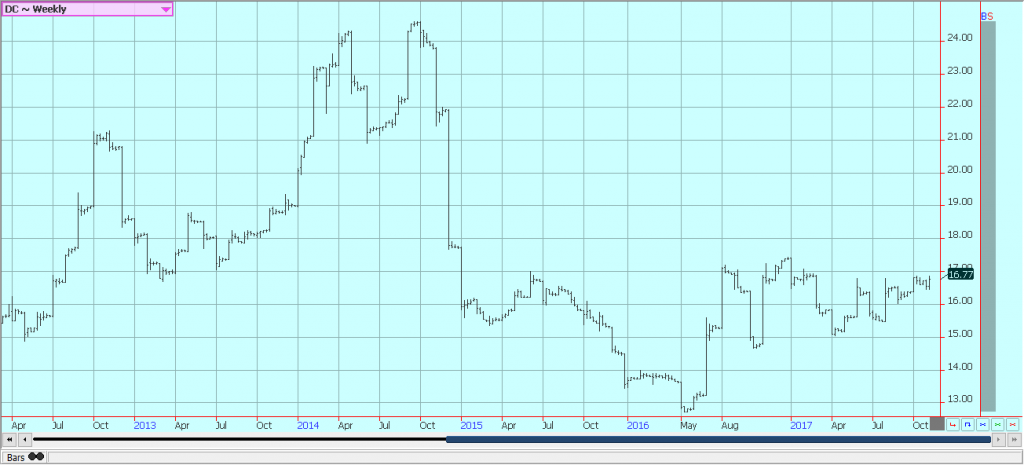
Weekly Chicago Class 3 Milk Futures © Jack Scoville
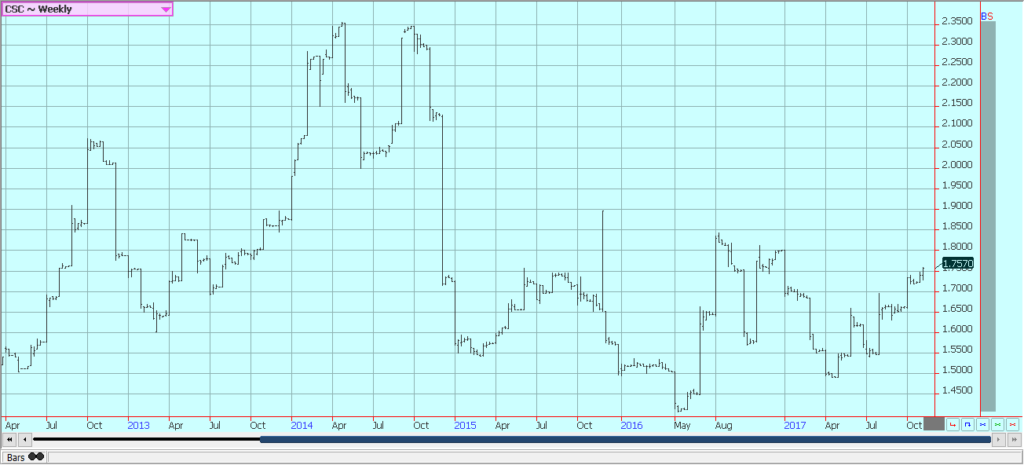
Weekly Chicago Cheese Futures © Jack Scoville
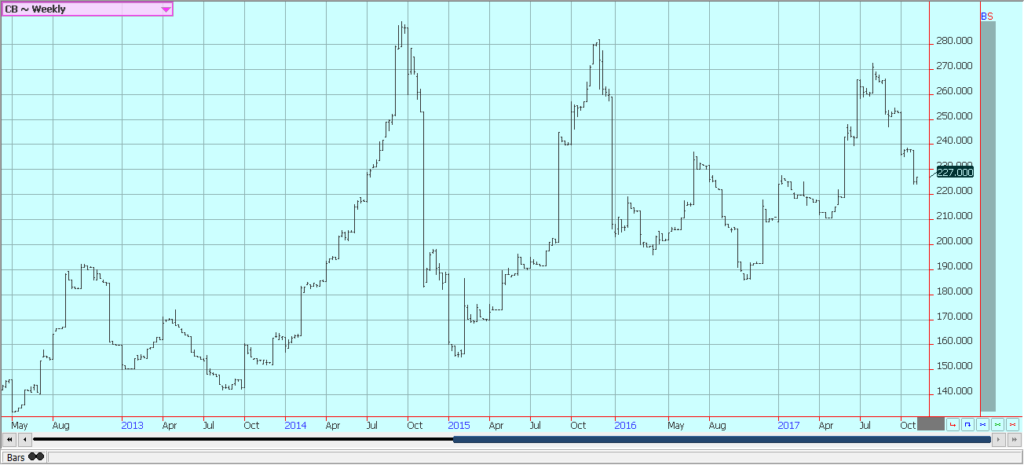
Weekly Chicago Butter Futures © Jack Scoville
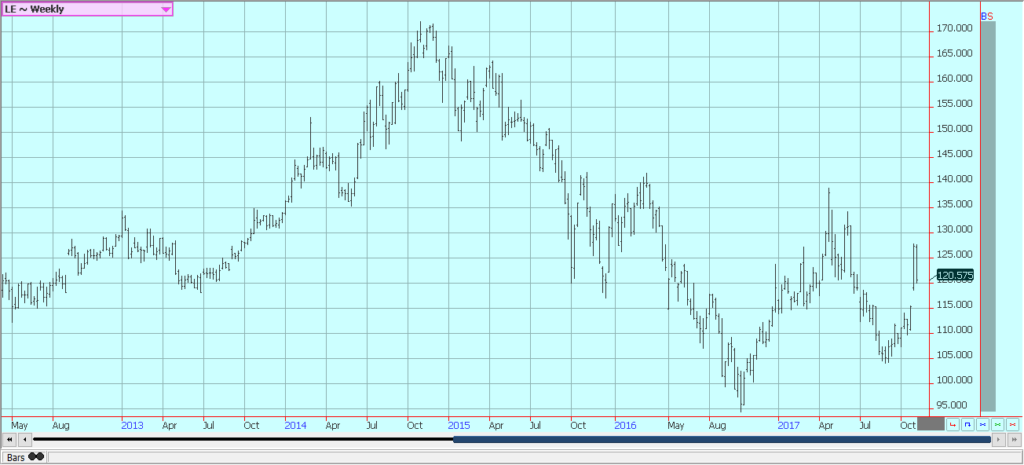
Weekly Chicago Live Cattle Futures © Jack Scoville
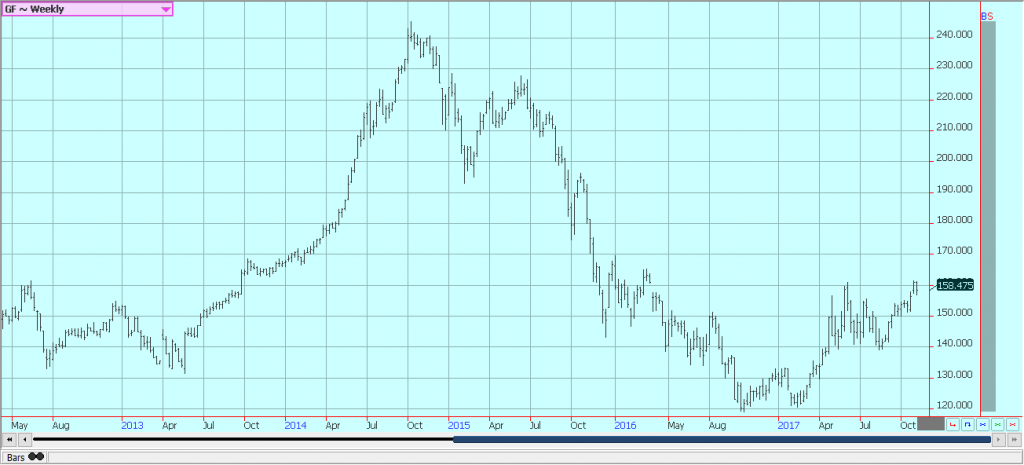
Weekly Feeder Cattle Futures © Jack Scoville
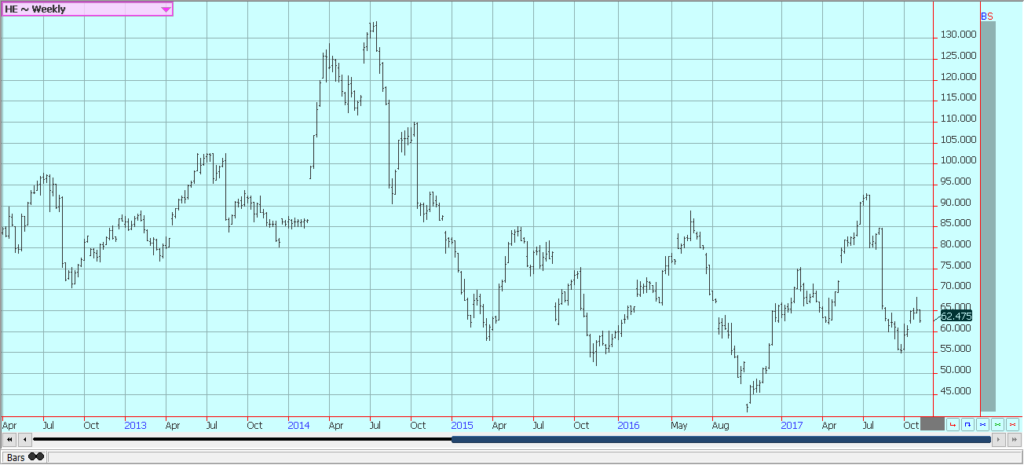
Weekly Chicago Lean Hog Futures © Jack Scoville
—
DISCLAIMER: This article expresses my own ideas and opinions. Any information I have shared are from sources that I believe to be reliable and accurate. I did not receive any financial compensation in writing this post, nor do I own any shares in any company I’ve mentioned. I encourage any reader to do their own diligent research first before making any investment decisions.

-

 Fintech2 weeks ago
Fintech2 weeks agoMuzinich and Nao Partner to Open Private Credit Fund to Retail Investors
-

 Fintech21 hours ago
Fintech21 hours agoRipple and Mercado Bitcoin Expand RWA Tokenization on XRPL
-

 Crypto1 week ago
Crypto1 week agoBitcoin Traders on DEXs Brace for Downturn Despite Price Rally
-

 Crowdfunding6 days ago
Crowdfunding6 days agoFrom Confiscation to Cooperation: Funding Casa de la PAZ’s Social Transformation

























You must be logged in to post a comment Login